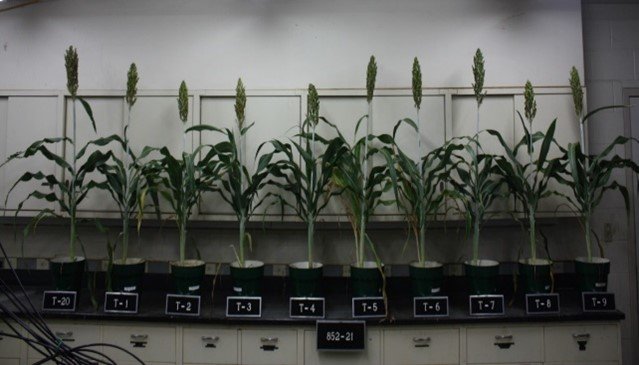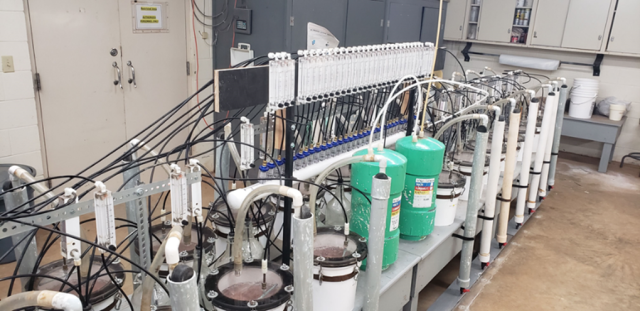EPA and USDA Leading Effort to Innovate the Next Generation of Industrial Fertilizers
Published September 9, 2022

Developed during the early 20th century, modern chemical fertilizers have made production of high-yield crops, such as corn and soybeans, possible at an industrial scale. However, the improper or overuse of many of these fertilizers, which often contain the nutrients nitrogen and phosphorus, can result in water and air pollution, greenhouse gas emissions, and harmful human health impacts. Despite substantial agricultural research and development investments to protect the environment in recent years, fertilizer innovation has not kept pace.
EPA senior research scientist Christopher Clark recognized that addressing this complex challenge required creativity and collaboration. He set up a team with representatives from the U.S. Department of Agriculture, the Fertilizer Institute (TFI), the International Fertilizer Development Center (IFDC), the Nature Conservancy (TNC), and the National Corn Growers Association (NCGA) to explore possible solutions to innovate sustainable fertilizer technologies in the U.S. As a co-lead of the competition, USDA contributed vital support for the idea, including technical expertise and prize money that allowed EPA to launch the idea. The group worked together with industry and affected stakeholders to understand the scientific and technical issues and hurdles, as well as socioeconomic and behavioral barriers to adopting these technologies.

The team used EPA’s Challenges and Prizes program to lead a research competition soliciting cutting-edge designs and technologies from the public to accelerate development and use of new fertilizer technologies to advance agricultural sustainability. A prize competition was an ideal mechanism to galvanize interest and support from fertilizer companies, farmers, environmental groups, and other stakeholders to identify and design new, efficient, and versatile fertilizer technologies. Dr. Clark credits the Challenges’ success to the involvement of its many partners. “This is an incredibly complex problem to solve and requires engagement from a broad stakeholder group so that we get it right,” he said.
The team launched a competition with two distinct challenges called the Next Gen Fertilizer Challenges. The competition focused on new and existing fertilizer and related technologies that control nutrient release or alter reactions in ways that reduce environmental impacts.
The first challenge, the Enhanced Efficiency Fertilizers (EEFs): Environmental and Agronomic Challenge, aimed to identify EEFs currently, or soon to be, available that can reduce the environmental effects of modern agriculture while maintaining or increasing crop yields. Forty-two submissions were reviewed by an external panel of experts across a range of technical areas. Sixteen products were selected to advance and are undergoing greenhouse trials at the IFDC in Muscle Shoals, Alabama. The 16 products that advanced cover a broad array of technologies, including fertilizers with biodegradable coatings capable of significant nutrient pollution reductions.
The second challenge, the Next Gen Fertilizer Innovations Challenge, aimed to identify concepts for novel fertilizer technologies and other product technology innovations not currently available on the market. Submissions could include technologies that are not traditional EEFs. After external review, nine teams’ submissions were selected as winners. Tied for the Challenge’s Tier I Winner, Taylor Pursell of Pursell Agri-Tech developed “Urea 2.0,” a technology capable of replacing the conventional fertilizer urea with a customizable mixture of inhibitors, micronutrients, and/or biological materials tailored to local climatic and soil conditions. Deploying a different strategy, the Challenge’s other Tier I winner, Dr. Christopher Hendrickson of Aqua-Yield, designed a “nano-smart-fertilizer” whereby nanoparticle cages carry fertilizer through the soil to the rooting zone and dissolve upon contact with plant roots into inert soil minerals and release fertilizers directly to the rooting zone. Both technologies show promise to improve nutrient uptake on a wide range of soil types.
On February 8 and 9, 2022, EPA held a virtual showcasing and workshop event where the winners, honorable mentions, and advancers of both challenges presented their technologies and concept designs and engaged with each other to learn about ideas, strategies, and new products.
Dr. Clark noted, “Working with such a passionate and dedicated team of partners that normally don’t sit down together has been a really inspiring experience as we all try to tackle this complex problem together.”
For Dr. Clark, the most rewarding part of the Challenges has yet to come – potentially witnessing greater adoption of these technologies and subsequent reduction in pollution to our air and water from nitrogen and phosphorus fertilizers across the U.S. When deployed, the novel technologies developed with support from the Challenges could provide farmers with cost-effective fertilizers that maintain or even increase crop yields while reducing greenhouse gas emissions and nutrient pollution to our nation’s waterways.
Resources:
EPA and USDA Announce Winners of the Next Gen Fertilizer Innovations Challenge
